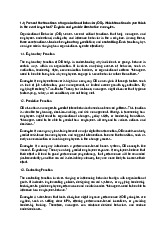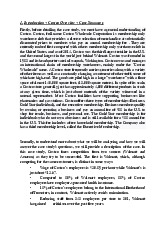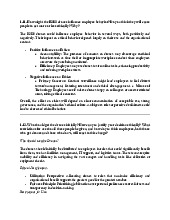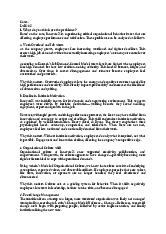










Preview text:
lOMoAR cPSD| 58591236 NATIONAL ECONOMICS UNIVERSITY SOCIALIST REPUBLIC OF VIETNAM
CENTER FOR ADVANCED EDUCATIONAL PROGRAMS
Independence – Freedom – Happiness SYLLABUS
FOR EXCELLENT UNDERGRADUATE PROGRAMS 1. GENERAL INFORMATION
Title: ORGANIZATIONAL BEHAVIOR Course Code: NLQT1101E General Education courses Units: 3 credits - Theoretical hours: 25 - Practical hours: 20
Prerequisite: Introduction to Management/Management.
2. LECTURER’S INFORMATION Full name: Pham Thi Bich Ngoc Tittle: Assoc. Prof., Dr.
Address: Building A1 , Room 606 Phone number: 0985623394 Email: ngocpb@neu.edu.vn
Faculty/ Institute: Faculty of Human Resource Economics and Management 3. COURSE DESCRIPTIONS
This course will review the concepts, theories and research in organizational behavior in
order to develop a comprehensive framework for understanding the performance of people in
work settings. Learning will be occurred at both the conceptual, theoretical and the applied
level. Areas covered by the course include organizational culture and structure, leadership,
groups and teams, motivation, and individual psychological factors which affect behavior of
employee at work. The course draws on the organizational experience of students and
encourages the practical application of the material covered.
Main topics will be covered as follows:
• Introduction to organizational behavior
• Diversity in organizations
• Attitudes and Job satisfaction
• Personality and Values and Perceptions • Motivation
• Foundations of group behavior • Communication lOMoAR cPSD| 58591236 • Leadership and Power • Organizational culture • Organizational structure
• Human resource management practices
4. LEARNING RESOURCES : COURSE BOOKS, REFERENCE BOOKS, AND SOFTWARES
- Course book: S. P. Robbins and T. A. Judge (2017). Organizational Behavior (17th Edition).
Prentice Hall, USA. - Reference books:
• Moorhead, G. and Griffin, R. W. (2012). Managing Organizational behavior, International
Edition, US, South-Western Cengage Learning
• John R Schermerhorn, Jr., Richard N. Osborn, James G. Hunt, Mary Uhl-Bien (2012)
Organizational Behavior: International Student Version (12th Edition). Wiley John & Sons.
• Laurie J. Mullins (2016). Management Organizational Behavior (11th Edition). Prentice Hall.
• McShane, S. L, Glinow, M. A. V. (2010), Organizational Behavior (5th Edition) The McGrawHill Companies, Inc., USA 5. COURSE GOALS
The course is designed to give students the basic knowledge of human behavior in organizations and
how to apply this knowledge to increase the organization effectiveness. After taking this class, the
students should all be able to:
• Demonstrate an understanding of basic theory and research related to contemporary issues in organizational behavior.
• Demonstrate an understanding of individual behavior and the links between individual behavior
and its social and organizational context.
• Demonstrate ability to apply OB theories to discuss work issues and to develop constructive
proposals for dealing with that issues.
• Exhibit analytical, research, teamworking and presentation skil s. Program Course Learning Goal Description Bloom level Goals Outcomes (PLO) [1] [2] [3] [4]
Demonstrate an understanding of OB concept, and G1
contemporary issues in organizational behavior 1.1 I, II
Demonstrate an understanding of individual
behavior and the links between individual behavior
and its social and organizational context, and ability G2
to apply OB theories to discuss work issues related 1.1, 1.3, 1.4 II, III, IV, V
to individual behavior and to develop constructive
proposals for dealing with that issues lOMoAR cPSD| 58591236
Demonstrate an understanding of mechanism for
developing effective teamwork in organizations and G3
ability to apply OB theories to discuss issues of 1.1, 1.3, 1.4 II, III, IV, V
group behavior and to develop constructive
proposals for dealing with that issues
Demonstrate an understanding of organizational
structure, culture and human resource management
practices on individual behavior and organizational G4
effectiveness and ability to apply OB theories to 1.1, 1.3, 1.4 II, III, IV, V
discuss the work issues and to develop constructive
proposals for dealing with that issues
Exhibit analytical, research, teamworking and 3.1, 3.2, 4.1, G5
problem solving, critical thinking, presentation VI skills. 4.2, 4.3
6. COURSE LEARNING OUTCOMES (CLO) Course goals CLO Descriptions Bloom level [1] [2] [3] [4] CLO 1.1
Remember important OB concepts I CLO 1.2
Understand the importance of OB in management II, III G1 CLO 1.3
Analyze the challenges and opportunities to OB IV
Evaluate different situations by using different OB CLO 1.4 theories. V
Understand the important individual behavior at CLO 2.1
work and individual differences II
Explain individual behavior by using different CLO 2.2 theories II
Compare the application of different motivational CLO 2.3
theories and their application within workplace III G2
Discuss the impact of individual factors on CLO 2.4 individual behavior IV
Evaluate the usefulness of a motivation theory for CLO 2.5 managers V
Propose solutions to facilitate positive behavior of CLO 2.6
individuals in an organization V, VI G3
Explain the nature of groups, team and group CLO 3.1
behavior and leadership theories in organizations II
Discuss factors that may promote or inhibit the CLO 3.2
development of effective group behavior and III, IV teamwork in organizations CLO 3.3
Evaluate different leadership theories and styles and V
its impacts on performance in organizations lOMoAR cPSD| 58591236
Propose solutions to deal with problems related to CLO 3.4 groupwork and teamwork V, VI
Compare and contrast different organizational CLO 4.1 structure and culture. III
Explain how organizational structure and culture, CLO 4.2
HRM practices can impact on individual behavior III
and performance of organizations G4
Evaluate different organizational structure models CLO 4.3
and cultures of different organizations and its IV, V applications in the workplace
Suggest organizational structure and culture models CLO 4.4
to fit with different organizations VI
Create a good team and work effectively together to CLO 5.1
complete the group assignments and group VI discussion.
Create competence to manage time effectively to CLO 5.2
complete all the individual assignment with high VI G5 performance.
Create competence to critical thinking in evaluating CLO 5.3 behavior issues. VI
Communicate effectively in English about issues CLO 5.4 related to OB VI 7. COURSE ASSESSMENT Assessment Assessment Percentage Description Time CLO methods indicators (%) [1] [2] [3] [4] [5] [6] Class Class participation points All CLO 5.3 Attendance 10%
Participation will be based on general sessions CLO 5.4 points class attendance, & contribution in class and Times of compliance with the class answers and rules delineated below. questions in
Students must attend more class. than 80% of contact hours in order to be accepted to the final examination. Students are expected to read all materials in advance and participate actively in the
discussion of articles, topics or case studies. Marks will lOMoAR cPSD| 58591236 be allocated according to the degree and quality of participation CLO 1.1 CLO 1.2 The mid-term exam consists of multiple-choice questions CLO 1.3 Multiple and short answer questions CLO 1.4 choice Mid-term which measure student’s CLO 2.1 Session 6 questions 20% exam understanding of the main CLO 2.2 and short concepts and their ability to CLO 2.4 answer apply them to different CLO 2.5 questions realworld situations. CLO 3.1 CLO 3.2 lOMoAR cPSD| 58591236 Group Students are required to Session CLO 2.3 Group 20%
Assignment work in groups of 4 to 6 11,12,13 CLO 2.6 presentation student each, briefly report CLO 3.3 and report on an aspect of CLO 3.4 Organizational behavior in CLO 4.3 practice for a chosen CLO 4.4 company. CLO 5.1 Each group will choose a CLO 5.2 company to write on CLO 5.3 selected organizational CLO 5.4 behavior issues in that company. Based on the theories acquired from this course, give your group’s recommendations to improve the company's organizational effectiveness. The input for the assignment must be based on your observation, direct interviews with managers and staffs of that company, and the company's documents. Maximum length of the group assignment should be 2500 words excluding appendices. The group assignment shall be submitted in session 10, before the presentation. Groups are expected to do a report and a presentation. The report needs to be submitted through Turnitin 2 days before the presentation. Evaluation will be based on both presentation and written report lOMoAR cPSD| 58591236 Final exam of 90 minutes. Students have permission to take the final exam when they attend more than 80% of the total classes and hand CLO 1.1 in both individual and group CLO 1.2 assignments on time. CLO 1.3 Makeup exams will not be CLO 1.4 offered. CLO 2.1 Multiple The final exam consists of CLO 2.2 choice multiple choice and essay CLO 2.4 University Final Exam questions questions which measure CLO 2.5 50% schedule and short your understanding of CLO 3.1 answer subject matters and your CLO 3.2 questions ability to analyze and CLO 3.3 discuss organizational CLO 4.1 behavior issues. Other types CLO 4.2 of questions may be CLO 4.3 included. The question will CLO 4.4 cover the lectures, class discussions, activities, exercises, and textbook.
8. LESSON PLAN (Any changes on the schedule WILL BE announced in class and on
TURNITIN in advance) 8.1. Theoretical hours Learning and teaching Assessment Class Topics CLO activities methods [1] [2] [3] [4] [5] TOPIC 1: INTRODUCTION Introduction to the - Readings: syllabus; CLO 1.1 Course - Text book: Chapter 1, page Questions & Week 1 CLO 1.2 Chapter 1: Introduction 40-78 Discussion to OB CLO 1.3
TOPIC 2: FOUNDATION OF INDIVIDUAL BEHAVIOR Week 2 Chapter 2: Diversity in CLO 2.1 - Textbook: Chapter 3 Questions & Organization CLO 2.2 Discussion Chapter 3: Attitudes and Job Satisfaction CLO 2.3 Chapter 5: Personality & Values CLO 2.1 Questions & Week 3 Chapter 6: Perception
CLO 2.2 - Textbook, Chapter 5, 6 Discussion
and individual decision CLO 2.3 making lOMoAR cPSD| 58591236 Chapter 7: Motivation
CLO 2.5 - Textbook, Chapter 7,8 Concepts CLO 2.6 Week Chapter 8: Motivation: Questions & 4,5 Discussion From Concepts to Applications
TOPIC 3: FOUNDATION OF GROUP BEHAVIOR Chapter 9: Foundations -Textbook: Chapter 9, 10 of Group Behavior CLO 3.1 Questions & Week 6 Chapter 10: CLO 3.2 Discussion Understanding Work CLO 3.3 Teams MID-TERM EXAMINATION Chapter 11: Textbook: Chapter 11, 12 Questions & CLO 3.1 Week 7 Communication Discussion CLO 3.2 CLO 3.1 Questions & Week 8
Chapter 12: Leadership CLO 3.2 -Textbook: Chapter 12 Discussion CLO 3.3
TOPIC 4: BEHAVIOR AT ORGANIZATIONAL LEVEL Chapter 15:
CLO 4.1 - Textbook: Chapter 15 Questions & Week 9 Foundations of CLO 4.2 Discussion Organization structure CLO 4.3 CLO 4.1 -Textbook: Chapter 16 Questions & Chapter 16: Week 10 CLO 4.2 Discussion Organizational Culture CLO 4.3
Please note: This schedule may change because of unforeseen circumstances. 8.2. Practical hours Learning and teaching Assessment Class Topics CLO activities methods [1] [2] [3] [4] [5]
TOPIC 1: INTRODUCTION TO ORGANIZATIONAL BEHAVIOR Questions & Introduction and - Case incident 1: Apple goes Week 1 CLO 1.4 Group Chapter 1 global discussion
TOPIC 2: FOUNDATION OF INDIVIDUAL BEHAVIOR
Chapter 2: Diversity in CLO 2.4 -Case incident 1: Pursuit of Organization Happiness: Flexibility Questions & Week 2 Group Chapter 3: Attitudes discussion and Job Satisfaction lOMoAR cPSD| 58591236 Chapter 5: Personality CLO 2.4 & Values Questions & - Case incident: On the Cost Week 3 Chapter 6: Perception Group of being nice - Exercises and individual decision discussion making Chapter 7: Motivation CLO 2.4 -Case incident 1: The Concepts demotivation of CEO pay Week Chapter 8: Motivation: - Case incident 2: Pay raises Group 4,5 discussion From Concepts to everyday Applications
TOPIC 3: FOUNDATION OF GROUP BEHAVIOR Chapter 9: Foundations - Case incident 1: Intragroup Discussion of Group Behavior Trust and Survival Questions Week 6 Chapter 10: CLO 3.4 Understanding Work Teams Chapter 11: CLO 3.4 -Case incident 1: Questions & Week 7 Communication Organizational Leveraging of Group Social Media discussion CLO 3.4 Questions & -Case incident: Leadership Week 8 Chapter 12: Leadership Group traits discussion
TOPIC 4: BEHAVIOR AT ORGANIZATIONAL LEVEL -Case incident 1: Creative Chapter 15: Deviance- Bucking the Questions & Week 9 Foundations of CLO 4.4 hierarchy. Group Organization structure - Case incident 2: Siemens’ discussion Simple Structure - Not CLO 4.4 -Case incident 1: Are Questions & Chapter 16: Week 10
Employees Happier working in Group Organizational Culture their own national cultures? discussion Week Group presentation CLO 2.3 -Presentation Presentation 11, CLO 2.6 -Q&A and report 12,13 CLO 3.3 CLO 3.4 CLO 4.3 CLO 4.4 CLO 5.1 CLO 5.2 CLO 5.3 CLO 5.4
Please note: This schedule may change because of unforeseen circumstances. lOMoAR cPSD| 58591236
9. COURSE REQUIREMENT & EXPECTATION Class Participation
Students must attend more than 80% of contact hours in order to be accepted to the final examination.
Students are expected to read all materials in advance and participate actively in the discussion of
articles, topics or case studies
Class participation points will be based on general class attendance, contribution in class and
compliance with the class rules delineated below:
- Arrive on time and be seated and ready to begin when the class begins. If you do arrive late
for more than 30 minutes, you will not be counted for that class. Note that this class is intended for registered students only.
- Come prepared – read the readings assigned.
- Turn off cell phones during classes.
- Do not engage in individual discussions - No food in class time
- Participate by contributing comments and questions during the discussions. The instructor
will call on students during the class if participants do not volunteer.
- Please use common courtesy and polite manners in class.
- I have no tolerance for acts of academic dishonesty Assignment and Exam
There are 1 individual assignment/midterm exam, group assignment, and 1 final exam. Each
assignment accounts for 20% of the total grade and one final exam of 90 minutes accounts for 50%
of the total grade. Students have permission to take the final exam when they attend more than 80%
of the total classes and hand in both midterm exam and group assignment on time. Make-up exams
will not be offered. The following rules apply to exams:
- Make a notation of the exam dates.
- Final Exam is an open-book exam, so students can use notes, books or other paper materials.
However, no technology will be allowed during the exam. You must turn off all cell phones
or any other personal technology.
- If you do not bring an ID to the exam, you will receive a 0 for the exam.
- No food or drinks will be allowed during an exam.
- Please make sure you do not engage in any behavior that may appear to be cheating.
Guidelines for writing up group assignment
There is not an exact format for assignment, one assignment usually has three parts: the
introduction, the discussion (the main body), and the conclusion. Specifically, one assignment
should cover the following issues:
- Structure: the assignment should have a clear logical flow from the introduction part to the conclusion part.
- Introduction: the introduction should be clear in the sense that it provides the reader an
indication of what you are going to do in this assignment. It should give the reader the
sufficient background or an overview of the context of organizational details in order to help
them to understand the practical aspects of your case. Shortly, the introduction part should
state clearly what the problems or issues that you are going to solve are. lOMoAR cPSD| 58591236
- The main body of the text: this session should use an appropriate blend of theory and practice.
You should ensure that tools, concepts, frameworks and theories mentioned in Organizational
behavior subject are used and applied in your assignment. For example, if you have decided
that you are going to explore the organizational culture issues, then you should be able to use
the seven characteristics described in the textbook to capture the essence of the culture of the
under-studied organization. You should demonstrate your critical analysis and evaluation in
this session. The issues should be discussed and argued clearly and logically, and are
supported by appropriate theories or practices.
- Conclusion: The conclusion part should address the main or critical points or issues drawn
from the discussion part. Based on your analysis and arguments in the previous parts you can
come up with recommendations for solving problems and issues raised.
This formal assignment will require more in-depth research and requires a minimum of three
references (other than the textbook, also encyclopedias are unacceptable). Teams will make their
presentations based on these findings in the two last sessions of the course. Late Assignments
All assignments are due by the date and time specified in the assignment. Late assignments will be
penalized 10% per calendar day (not merely per class period) beginning with the due date. After
three late days, acceptance of the assignment is at my discretion. No extensions, no exceptions. It is
your responsibility to know the due dates and to plan accordingly. Intellectual Property:
All materials presented in class lectures including PowerPoint presentations and those materials given
are intellectual property of the instructor unless otherwise copyrighted. Any reproduction or
publication of this material without prior written permission is strictly forbidden.
10. DATED: 1 August 2021 CENTER FOR ADVANCED
FACULTY LECTURER EDUCATIONAL PROGRAMS
Assoc. Prof., Dr. Pham Thi Bich Ngoc




